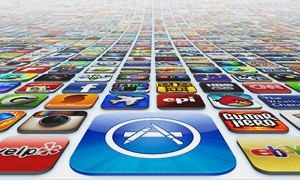In the ongoing war between Apple and Google, Apple can at least claim one victory. Its App Store is a relative money-making machine — making more money than any other app store including Google Play. Although Google Play leads in number of downloads, it trails Apple in app store revenue, according to market research firm Canalys.
 Out of the leading app stores in more than 50 countries, Apple’s App Store took in the largest proportion of revenue — around 74% — among the four largest stores: the App Store, Google Play, the Windows Phone Store and BlackBerry World. Google Play saw the largest number of downloads — about 51% of the stores’ collective total — with Apple close behind.
Out of the leading app stores in more than 50 countries, Apple’s App Store took in the largest proportion of revenue — around 74% — among the four largest stores: the App Store, Google Play, the Windows Phone Store and BlackBerry World. Google Play saw the largest number of downloads — about 51% of the stores’ collective total — with Apple close behind.
App downloads across the four stores – Apple’s App Store, Google Play, the Windows Phone Store and BlackBerry World – climbed 11% in Q1 2013 worldwide over the Q4 2012 total, while direct revenue from paid-for apps, in-app purchases and subscriptions combined grew by a slightly more modest 9%. Combined, we downloaded more than 13.4 billion apps last quarter, and revenue reached $2.2 billion, before revenue sharing is taken into account.
“Apps have had a huge impact on the way consumers use mobile devices, what they value, and what they expect from smart phones and tablets. They are now central to how consumers engage with content and connected services, and how they personalize their devices around the app-enabled features that are important to them,” says Adam Daum, Canalys Chief Analyst for Analytics. “This is a multi-billion-dollar growth market, on a growing addressable base of smart phones and tablets.”
Some of the strongest growth was seen in emerging markets, such as South Africa, Brazil and Indonesia, helped not least by the growing base of smart device users in those countries. But this growth, both in revenue terms and download volumes, was seen mainly in mature mobility markets, such as North America, up 8% and 6% respectively, and Western Europe, up 8% and 10% in Q1.
“Apple’s App Store and Google Play remain the heavyweights in the app store world. In comparison, BlackBerry World and the Windows Phone Store remain distant challengers today, though they still should not be ignored,” says Tim Shepherd, Canalys Senior Analyst. “Each of these four stores represents a different market proposition for developers, and remains the primary outlet to reach users on the platforms they serve.
“BlackBerry and Microsoft particularly need to continue to proactively work to attract fresh, innovative content and services to their respective catalogs, and fill gaps in their inventories,” says Shepherd. “But they also need to increase device sales around BlackBerry 10 and Windows Phone 8 to increase the addressable market opportunities on offer to developers.”
BlackBerry 10 now has more than 100,000 apps available through its storefront, showing good growth from the 70,000 it boasted at launch, and the new devices on the platform have given BlackBerry a much greater chance to compete for consumer attention, Shepherd points out.
Microsoft, with the help of partners such as Nokia, is also making good progress attracting some important titles to the Windows Phone platform, but it too needs to do more. “Microsoft needs to make building apps for its platform a priority for developers and also do a better job of marketing and communicating the already established strength of its app story,” says Shepherd.
Just because an app store is making lots of money, doesn’t mean that developers will make big bucks, too. Nearly 90 percent of all mobile apps are free, and in the US, half of the total app revenue is only going to the top 25 developers.
You can see more information on Canalys’ “App Interrogator” research program here.





